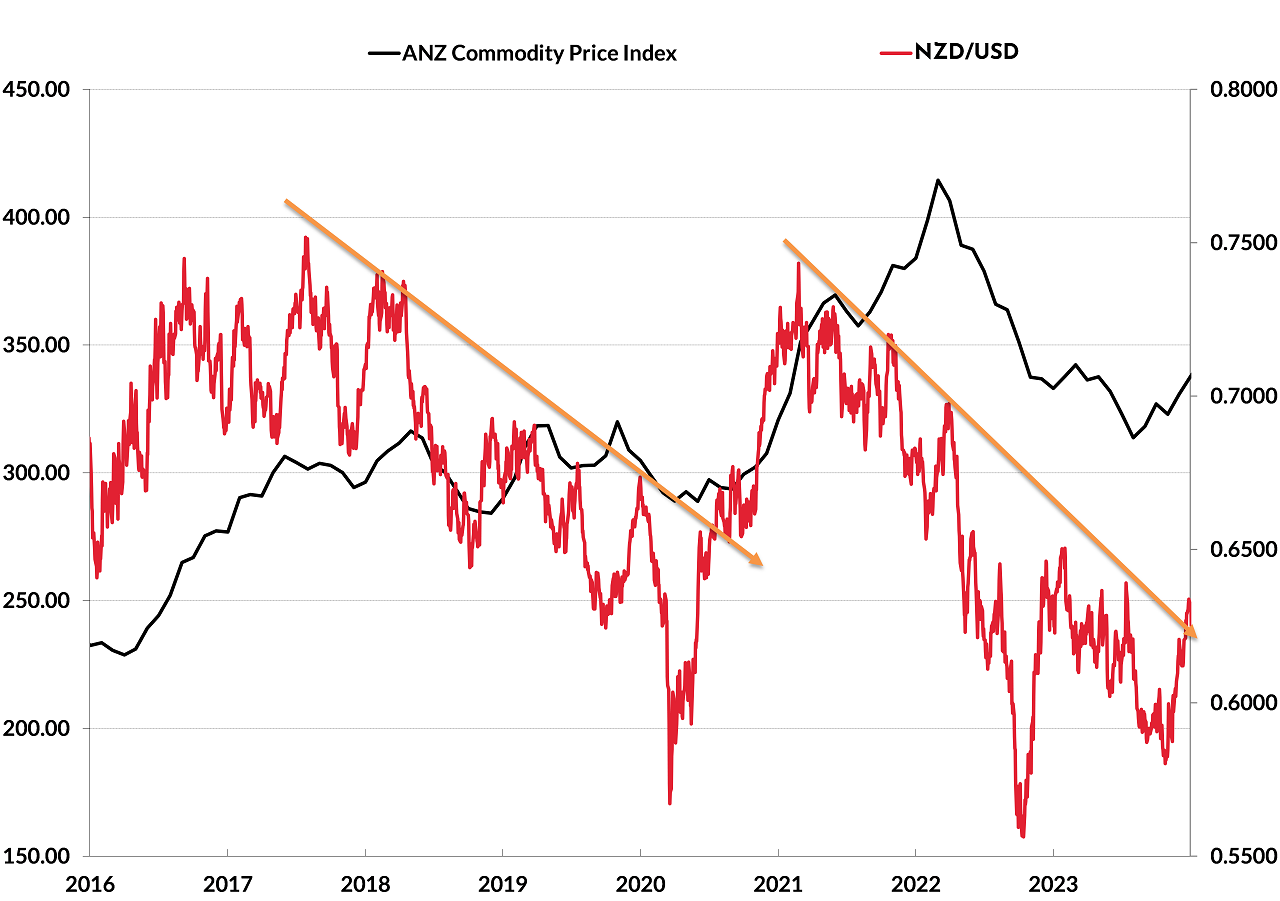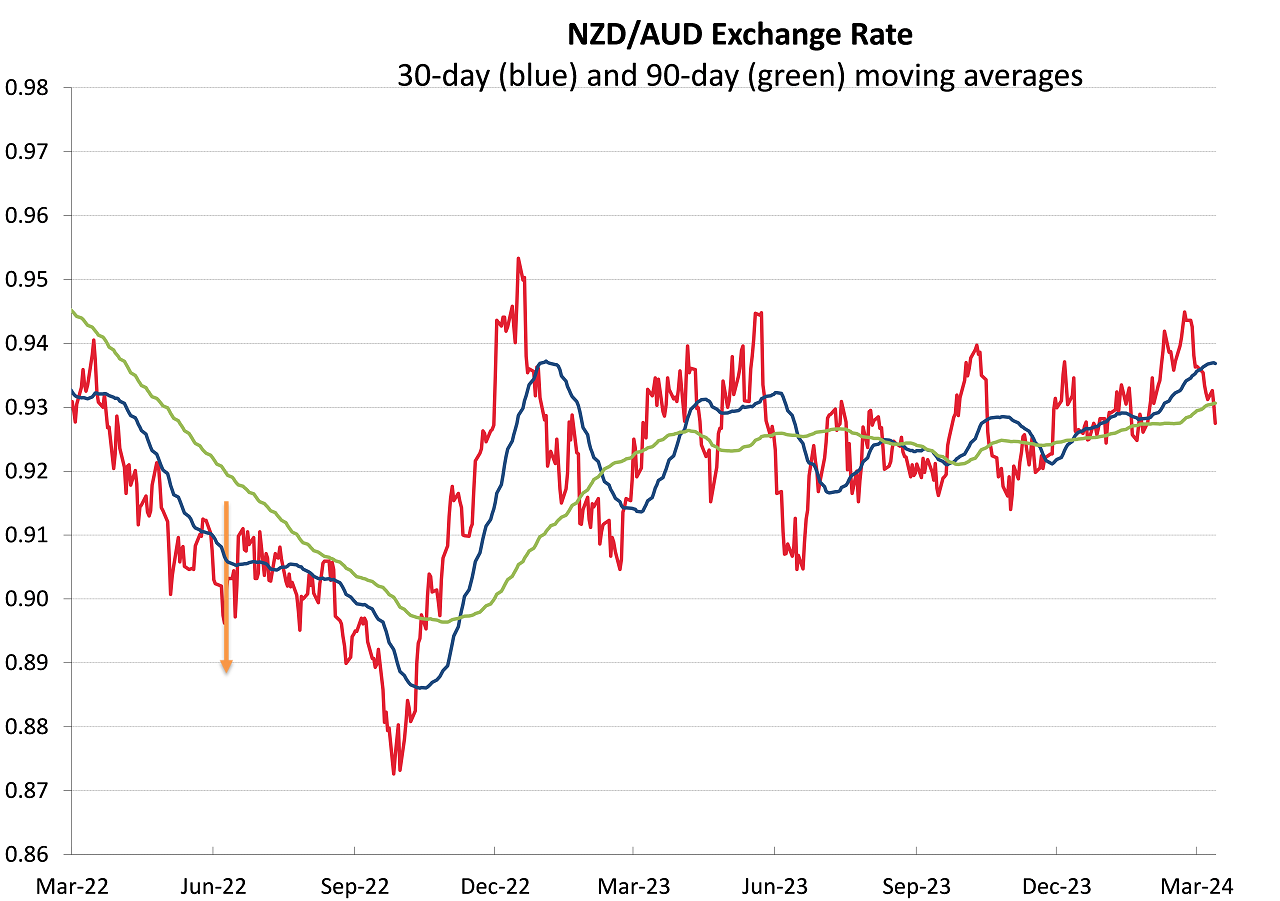
- Oil price increases disrupt the US inflation outlook
- The repeating patterns of the Kiwi dollar’s up and down movements
- Spike higher in NZD/AUD cross-rate does not last
Oil price increases disrupt the US inflation outlook
The headlines in the US financial media certainly scare the horses in the equity, bond and currency markets.
Over the last month repeated headlines of “hotter than expected inflation numbers” have caused equities to fall, bond yields to increase and the US dollar to strengthen. It is not the case that the underlying trend of inflation reducing to the 2.00% Federal Reserve target is seriously under threat. However, the markets have certainly reacted adversely to the higher-than-expected January and February Producers Price Index increases (PPI - wholesale prices). The NZD/USD exchange rate is trading back below 0.6100 due to a rebound upwards in the USD Index as a result of the February PPI increasing by 0.60%, well above the +0.30% prior consensus forecast. The increase was entirely due the crude oil price lifting from US$72/barrel to US$78/barrel during the month of February. The core PPI measure (which excludes fuel prices) is still only increasing at an annual rate of 2.00%.
The US interest rate markets are now questioning whether the Fed can make 4 x 0.25% cuts to interest rates this year, commencing in June. We would not read too much into the recent jump back up in US 10-year bonds yields from 4.10% to 4.30%. Previous short-term increases of this magnitude have not been long lasting as subsequent economic data has proven to be softer. Retail sales, PMI manufacturing and PMI services have all been examples of this in recent weeks.
The Fed will not be changing their view or stance due to these recent oil price-induced increases in wholesale prices. Their mandate is on the core inflation rate which excludes volatile food and energy prices. They also know that crude oil prices can reverse back down as fast as they go up. The recent increase in oil prices being due to Ukrainian attacks on Russian oil refineries.
The US 10-year bond yield and the USD Index are likely to reverse back down again when the PCE inflation measure is released for February on 28th March. Ahead of that data set will be the Fed meeting on 20th March, wherein little change is expected in their statement wording or rhetoric.
The repeating patterns of the Kiwi dollar’s up and down movements
Repeating patterns of movement has been a feature of the NZD/USD exchange rate direction for some time now. Over the last seven years, the Kiwi dollar has moved in three clear cycles of down, up and down again. The chart below depicts the two large down-cycles over that seven-year period.
The First Kiwi dollar slide of 2017 to 2020 from a high of 0.7500 to 0.5600 was due to a strong US economy and therefore a strong US dollar at the time, the Covid pandemic initially driving safe-have funds flows into the USD, as well as a left-leaning, Ardern Labour Government in New Zealand driving foreign investment away.
The first Kiwi dollar recovery from below 0.6000 to 0.7500 in 2020/2021 was due to the US Federal Reserve slashing interest rates as the Covid pandemic hit their economy and therefore the USD weakened against all currencies.
The second Kiwi dollar slide in 2022 and 2023 from 0.7400 to 0.5600 was due to US increasing their interest rates (higher US inflation from the Covid money printing and the Ukraine war) and therefore a stronger USD during this period. In addition, a weaker Chinese economy and lower commodity prices from their highs weighed on the Kiwi dollar value.
What are the chances of a second Kiwi dollar recovery upwards from current levels to continue the down, up, down and up again sequence?
There have been a few false starts for the Kiwi dollar to recover back upwards from the dramatic sell-off to 0.5600 at the time of the UK Gilt financial shock/risk event in October 2022. The subsequent rapid recovery to 0.6500 in early 2023 could not be sustained as US economic data printed stronger than expected through this period and the timing of the US Fed pivoting away from tight monetary policy was continually postponed i.e. the USD remained strong through 2023 until October. The Fed’s pivot on monetary policy finally arrived in December 2023, allowing the Kiwi dollar another rapid ascent from 0.5800 to 0.6350. However, again the movement higher in the Kiwi was another false start to a new uptrend. The timing of US interest rate cuts by the Fed are now being pushed out further away as the debate continues around the difficulty in getting the “last mile” of US inflation reductions from 3.00% to 2.00%. The NZD/USD rate has oscillated around the 0.6100 region for several weeks now, awaiting more convincing confirmation that US inflation and employment data is weaker in 2024, to allow US interest rates to decrease and the USD to weaken.
Following the chart patterns, the Kiwi dollar needs to convincingly move above the downtrend line at 0.6250 to break out of the downtrend and start to appreciate. Over recent weeks the Kiwi dollar has not had the favourable conditions of a constantly weakening US dollar value to allow it to propel into the next “recover higher” phase.
The previous high and reliable correlation of NZD/USD movements to our export commodity prices has broken down somewhat in recent years. However, it is never forgotten by global FX market traders and investors that the Kiwi dollar will always be a “commodity” currency and once the interest rate gap to the US widens again, it should attract some favour.
The counterargument to the view that the Kiwi dollar could be on the cusp of another recovery to the high 0.6000’s, is weaker NZ economic data suggesting earlier interest rate cuts here and therefore the Kiwi dollar will not benefit from any interest rate differential to the US as both interest rates fall in tandem later this year. The problem with this view is that it is based on NZ inflation declining rapidly from the current 4.70% level over the next six months to allow the RBNZ to cut interest rates earlier.

Spike higher in NZD/AUD cross-rate does not last
The NZD/AUD cross-rate has spiked higher to 0.9400 on six separate occasions over the last 15 months. As the chart below shows, none of the increases have been sustainable and the exchange rate has always rapidly reversed back down. The pattern has again repeated over the last few weeks with the NZD/AUD rate plummeting from 0.9450 on 22nd February to 0.9275 on 15th March. The Kiwi dollar has under-performed the AUD against the USD due to weaker economic data on this side of the Tasman encouraging some to think the RBNZ will cut interest rates earlier. The reality is more likely to be that the NZD selling against the AUD is fund managers in New Zealand taking the opportunity to buy AUD’s more cheaply or reducing their sold AUD/bought NZD portfolio FX hedges. Alternatively, it could also be Australian fund managers reducing their NZ equity weightings (selling NZD, buying AUD) as the NZ share market underperforms.
Local AUD exporters who have been holding off from replacing hedging over recent weeks, should now be prepared to enter new hedges with FX orders placed between 0.9200 and 0.9000.

Daily exchange rates
Select chart tabs
*Roger J Kerr is Executive Chairman of Barrington Treasury Services NZ Limited. He has written commentaries on the NZ dollar since 1981.
3 Comments
The US interest rate markets are now questioning whether the Fed can make 4 x 0.25% cuts...
Can't see it. I'm somewhere between zero and one this year. US inflation has just been steady at 3%-4% since May last year, nowhere near necessitating a cut.
Most Kiwis should probably be more concerned with what higher oil prices and weakening Kiwi peso means for us at home.




We welcome your comments below. If you are not already registered, please register to comment.
Remember we welcome robust, respectful and insightful debate. We don't welcome abusive or defamatory comments and will de-register those repeatedly making such comments. Our current comment policy is here.